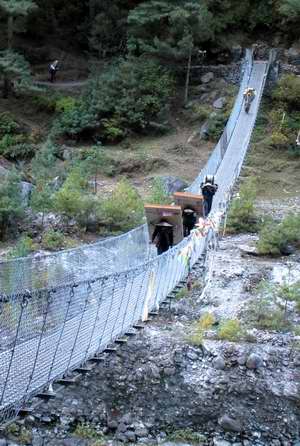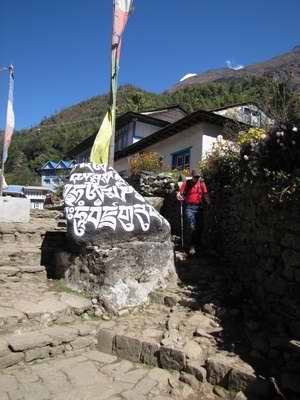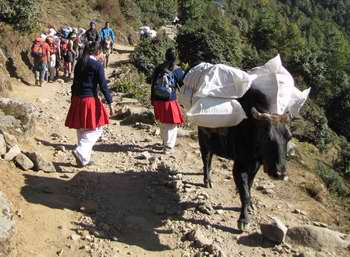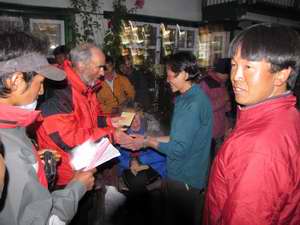Despite sleeping in the lodge,
we still had bed-tea and warm washing water brought to our rooms. We
had breakfast at 07.00, and then everything seemed to slow down. We
thought that we had an early flight out of Lukla, but our bags remained
unmoved in the courtyard which was now crowded with other groups also
waiting for their flights. Eight o'clock came and went, as did nine
o'clock. We could hear the odd plane land, and more easily hear them
take off, as they had to go up to full throttle at the end of the short
runway for a while before releasing the brakes and roaring down the
steeply sloping runway and (hopefully) into the air.
Eventually at 09.45 we got our boarding cards and went to the terminal
and through security - no electronic stuff here, just a brief
interrogation and ferret through our bags. Then we waited some more -
no planes appeared for almost an hour - until eventually our flight ,
106, was called.
|
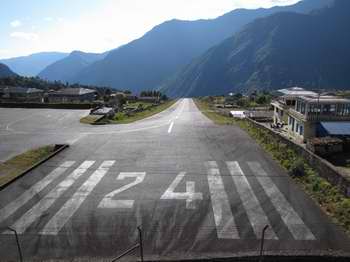
The short runway at Lukla
|
|
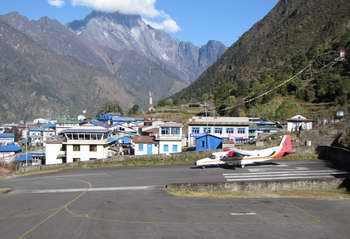
|
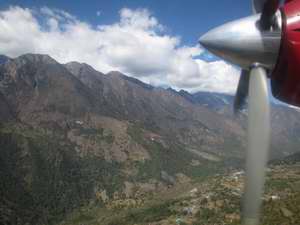
Last view of the Dudh Kosi valley
|
|
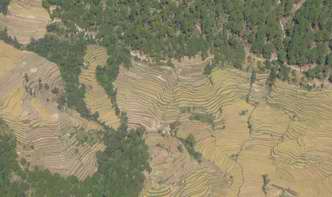
Terraced fields seen from the plane
|
|
Most of us had window seats, as
there was only one seat either side a central aisle, and we had
stunning views of the ridges and valleys as we passed over. Initially
there was no habitation, and single tracks up the ridges. Then
gradually the area of terraced agricultural land increased and there
were more tracks. Eventually I spotted a road with a vehicle on it -
the first thing on wheels for over three weeks!
We crossed low over the Nagarkot ridge and into the pollution of the
Kathmandu valley. On landing we were met again by the chief of the
Wilderness Experience trekking company, Ang Phurbar, who had done
all the local organisation for us. As some of our luggage was on a
separate flight we had to wait a while for all our bags to arrive. Once
complete we set off by bus to go to a hotel at Nagarkot - the place we
had only just flown over.
|
The journey, although short in
distance, took almost two hours as the traffic of lorries, farm
vehicles, motorbikes and taxis was heavy, and the main road was being
(slowly) upgraded. We had plenty of time to observe the contrasts in
the Kathmandu suburbs: half finished buildings, adverts for flat-screen
TVs, army bases, wheat and rice fields squeezed between buildings,
grain drying on tarpaulins, stooks drying in the fields, haystacks,
brickfields, motorbikes, motorbikes, motorbikes,
Eventually we reached Nagarkot, a ridge about 2,000m in altitude, from
which there are uninterrupted views of the Himalayan range from the
Khumbu area in the east (Everest was just visible as a pimple) to the
Annapurna area in the west. There are lots of hotels on the ridge, and
a dirt road that hasn't kept up with the development.
We spent a relaxed night here, watching the sun go down, and dining ( a
buffet with tough beef chilli) in
a real dining room.
|
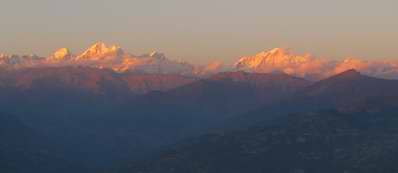
Sunset over the Langtang Himalaya seen from Nagarkot
|
|
Sunday 8 November
|
|
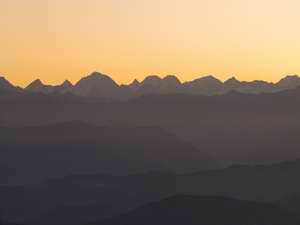
Sunrise over the Himalayan range
|
|
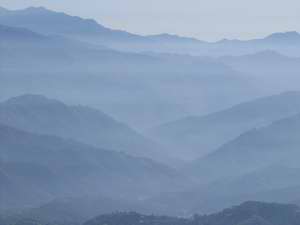
Misty ridges from Nagarkot
|
|
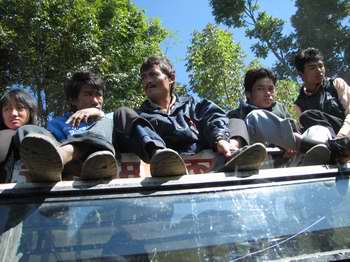
|
Despite being tired I did manage
to peer out of the window at dawn, and then at various intervals got
back out of bed as the colour of the sky changed, and the mist in the
valleys gradually dispersed.
The journey back into Kathmandu was even slower than the journey out,
and it took two and a half hours to reach the Kathmandu Guest House.
Once again we had time to look at the variety of traffic on the roads,
from buses filled to the brim (including the roof) down to overloaded
motorbikes.
Back in the centre it was time for lunch, and a number of us tried
another of the roof-top restaurants that serve a 'fusion' menu i.e.
Nepali food with international dishes too. Then we dispersed for our
individual shopping missions - for maps, postcards, pashmina shawls
etc.
|
We met up again at 18.30 for our
final meal together, as Christina was leaving the next day. Although
not far from the hotel it took ages, in two minibuses, to wind our way
through the dark traffic-filled streets to the restaurant located in a
renovated palace building. Shoes were left outside and legs were
carefully folded so that we could get down on cushions at the low
tables. This was a real tourist experience: numerous small tasty dishes
interspersed with dancing displays of the various Nepali traditions.
The food items included spicy potato, popcorn, soup, rice, spinach,
fish chunks, chicken, tomato, mushrooms, and yogurt with red chunky
bits - not altogether! A fitting official end to the trek, accompanied
as we were by Ang Phurbar and Ang Jambu (and his wife), the main
organisers from Wilderness Experience of the trek.
|
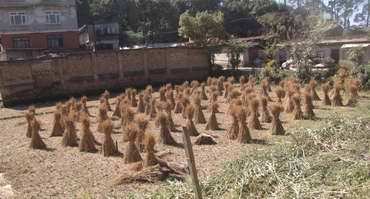
Stooks of grain drying in a field in Kathmandu suburbs
|
|
Back
to
top
|
|
To previous
log
|
Next log
|

